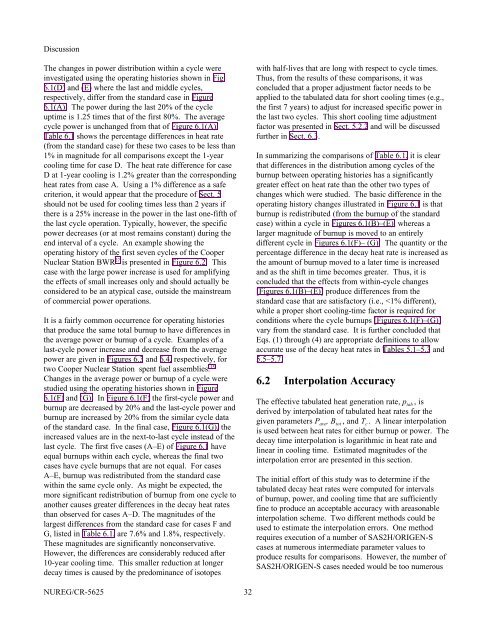NUREG/CR-5625 (ORNL-6698) - Oak Ridge National Laboratory
NUREG/CR-5625 (ORNL-6698) - Oak Ridge National Laboratory
NUREG/CR-5625 (ORNL-6698) - Oak Ridge National Laboratory
You also want an ePaper? Increase the reach of your titles
YUMPU automatically turns print PDFs into web optimized ePapers that Google loves.
Discussion<br />
The changes in power distribution within a cycle were with half-lives that are long with respect to cycle times.<br />
investigated using the operating histories shown in Fig. Thus, from the results of these comparisons, it was<br />
6.1(D) and (E) where the last and middle cycles,<br />
concluded that a proper adjustment factor needs to be<br />
respectively, differ from the standard case in Figure<br />
applied to the tabulated data for short cooling times (e.g.,<br />
6.1(A). The power during the last 20% of the cycle<br />
the first 7 years) to adjust for increased specific power in<br />
uptime is 1.25 times that of the first 80%. The average the last two cycles. This short cooling time adjustment<br />
cycle power is unchanged from that of Figure 6.1(A). factor was presented in Sect. 5.2.2 and will be discussed<br />
Table 6.1 shows the percentage differences in heat rate further in Sect. 6.3.<br />
(from the standard case) for these two cases to be less than<br />
1% in magnitude for all comparisons except the 1-year In summarizing the comparisons of Table 6.1, it is clear<br />
cooling time for case D. The heat rate difference for case that differences in the distribution among cycles of the<br />
D at 1-year cooling is 1.2% greater than the corresponding burnup between operating histories has a significantly<br />
heat rates from case A. Using a 1% difference as a safe greater effect on heat rate than the other two types of<br />
criterion, it would appear that the procedure of Sect. 5 changes which were studied. The basic difference in the<br />
should not be used for cooling times less than 2 years if operating history changes illustrated in Figure 6.1 is that<br />
there is a 25% increase in the power in the last one-fifth of burnup is redistributed (from the burnup of the standard<br />
the last cycle operation. Typically, however, the specific case) within a cycle in Figures 6.1(B)–(E), whereas a<br />
power decreases (or at most remains constant) during the larger magnitude of burnup is moved to an entirely<br />
end interval of a cycle. An example showing the<br />
different cycle in Figures 6.1(F)– (G). The quantity or the<br />
operating history of the first seven cycles of the Cooper percentage difference in the decay heat rate is increased as<br />
27<br />
Nuclear Station BWR is presented in Figure 6.2. This the amount of burnup moved to a later time is increased<br />
case with the large power increase is used for amplifying and as the shift in time becomes greater. Thus, it is<br />
the effects of small increases only and should actually be concluded that the effects from within-cycle changes<br />
considered to be an atypical case, outside the mainstream [Figures 6.1(B)–(E)] produce differences from the<br />
of commercial power operations.<br />
standard case that are satisfactory (i.e.,
















